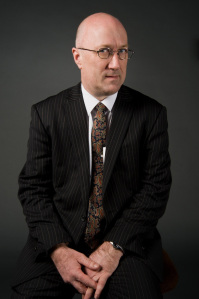Dave Patten is responsible for all public facing IT and AV, including interactive exhibits, at the Science Museum in London.
Dave talked with us about connecting visitors to museum content, and the role technology plays in that process.
The content is everything
Visitors don’t visit museums for their tech. Rather, they seek meaningful encounters with collections. The role of exhibitions is to facilitate that encounter by telling stories. New media offer one means of doing so, but may not be the best fit for every story. The most recent tech might draw too much attention to itself, or juxtapose oddly with the themes of the exhibit. Other times the latest gadget is still too experimental, or is too expensive. As Head of New Media, Dave’s job is as often to steer curatorial and exhibit teams away from an exciting new technology as it is to suggest a new, unfamiliar tool. That approach buys a lot of trust and goodwill. It also helps teach non-technologists that technology is no big deal, its just another tool.
A recent exhibition at the Science Museum, the Web Lab, shows both the challenges and the power of pushing the technological envelope when the tech is itself part of the story. Web Lab was an html5 based multi-user platform that allowed onsite visitors to collaborate with people online as they manipulate onsite installations together. The exhibit could only be fully accessed through Chrome, although it was designed to work without plug-ins or extras. And it was open 24/7 to online audiences (with all the support challenges that brought). An extremely complex project, it would not have been feasible without its for-profit partners, such as Google, which brought the initial proposal to the Museum, along with a different set of development practices, which ultimately offered new ways of engaging museum visitors.
Technology should move our practice forward
Perhaps unsurprisingly, the exhibit development process took on some of the flavor of tech development. Most of the time museums revise, finalize and approve the exhibit, only then opening to the public. The process requires significant front-end testing, evaluation and revision, but at some point the various teams sign off on the final draft and that is it. In contrast, technology companies roll out beta versions of their whole software, and gather information from what happens as the program is used in order to keep revising, adding features, and improving the final product. With Web Lab, the museum tried the latter approach for the first time, inviting visitors to participate in the process of revision once the whole exhibit was installed. The museum found that visitors were pretty thrilled to be invited to contribute to the final product and did in fact make a number of changes not only to the software, but also to the installation (including modifying the exhibit path). For the museum, this opened up the opportunity to evaluate the totality of the exhibit and Dave is thinking carefully about how that model might inform the practice of designing exhibits going forward.
Technology has and continues to change museum audiences
The right tool capitalizes on what potential museum audiences are already doing online. When most people go online searching for content, they don’t start at a museum website, rather they go to platforms that aggregate content for them. They might run a google search, check YouTube for videos, or start at a Wikipedia page. Increasingly, museums have to pay attention to where their online audiences are and go to them. Chances are, pieces of a museum’s collection already exist somewhere on the web and outside the institution’s direct control. This might mean revising content that already exists, or competing with it by offering better content (better quality videos for example). Museums also have to pay attention to how visitors consume content. Visitors don’t want another museum app, they want to be able to keep doing what they’re already doing to engage with your exhibit. Increasingly they are also bringing their own devices into the galleries with them, which means access to a whole landscape of content. As Dave points out, this lays the burden on museums to consider where their voice exists in the larger universe that is the web (something of a reverse, or 21rst century update to the concept of the multi-vocal museum!).
In that spirit, I leave you with Dave’s mantras
- you can predict the pace of technological change
- you can’t predict the revolutionary bits of technology
- don’t wait for the next best thing
- play, experiment, and don’t be afraid to fail
